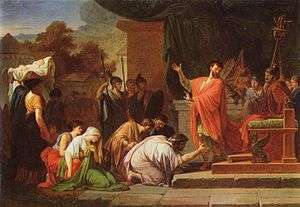Jean-François Pierre Peyron


Jean-François Pierre Peyron, full name of Pierre Peyron (15 December 1744 – 20 January 1814), was a French Neoclassical painter.
Biography
Peyron was born in Aix-en-Provence, where he studied art under Claude Arnulphy.[1] He was later a pupil of Lagrenée and was regarded as among the best painters of his generation.
He was one of the first to re-apply the Classic principles of composition, in the manner of Poussin, while the prevailing fashion was in favour of Rococo.
He won the prestigious Prix de Rome in 1773, ahead of David who was also a candidate. He spent the years between 1775 and 1782 in Rome, with the Academy of France in Rome.
On his return to Paris, Peyron found that the career of David had taken its rise and has completely eclipsed his own, relegating it to a minor role in the history of art - which became evident in the exhibitions at the Salon of Paris between 1785 and 1787. David did, however, pay homage to Peyron at the time of his funeral, stating: “He had opened my eyes.” Peyron died in Paris, aged 69.
List of works (partial)

- The Death of Seneca (1773) - a lost painting, which won Peyron the Prix de Rome
- The outcast Belisarius receiving hospitality from a peasant (1779), Musée de Augustins, Toulouse
- The Funeral of Miltiades (1782), The Louvre, Paris
- The Resurrection of Christ (1784), Church of Saint-Louis-en-l'Île, Paris
- The Death of Alceste (1785), The Louvre, Paris
- The Death of Socrates (1787), Statens Museum for Kunst, Copenhagen
- King Perseus of Macedon in front of Aemilius Paulus
Notes
References
- Pierre Rosenberg and Udolpho Van De Sandt, Pierre Peyron, 1744-1814 , 1983, éd. Arthéna ISBN 2-903239-02-9
External links
| Wikimedia Commons has media related to Jean-François-Pierre Peyron. |
- Insecula on Jean-François-Pierre Peyron
- Web Gallery of Art - Pictures
- Web Gallery of Art - Biography